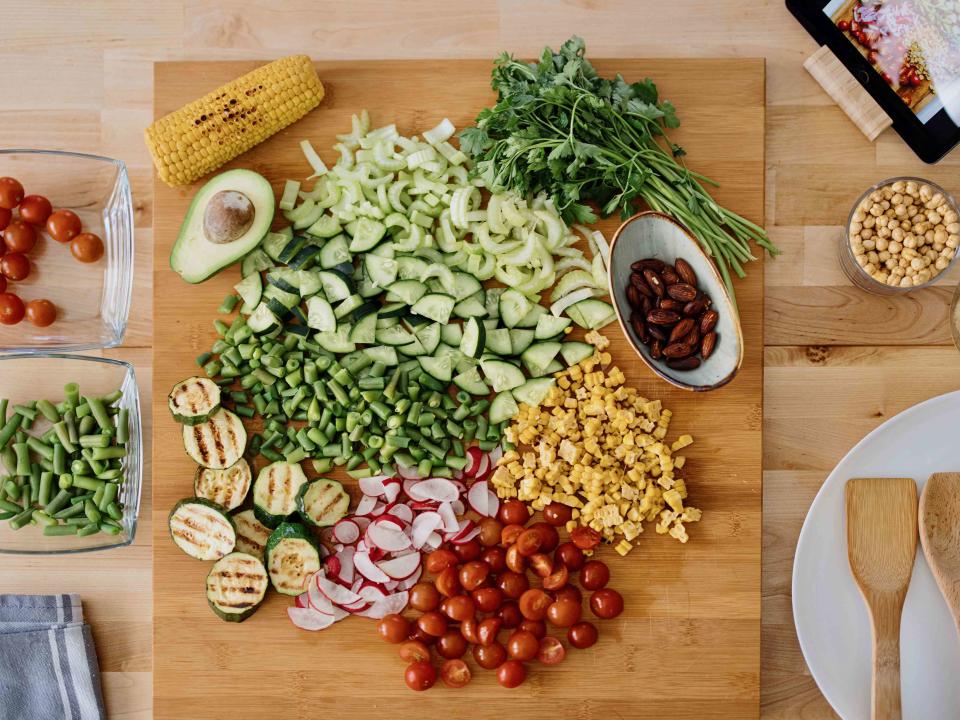What Is Mise En Place, and Why Is It Important?
This insider technique from French restaurant kitchens is guaranteed to minimize stress and mess in your home kitchen — no matter what’s on the menu.

Anchiy/Getty Images
We've all known the pain of making it halfway through a recipe only to realize that you're missing an ingredient or you need to pump the brakes to pause and rush-chop a vegetable. Not only does this create a frustrating experience, but it can have a detrimental effect on the finished dish. Never fear, flustered cooks — restaurant chefs learned the hard way long ago, and we're here to let you in on the secret of mise en place.
What Does Mise En Place Mean?
Directly translated from French, mise en place means "everything in its place." In the context of cooking, mise en place is all about preparation. Preparing for everything you need before cooking starts so the only work you have to do is the actual cooking. This means gathering and organizing ingredients, as well as cookware, before you ever turn on a burner. Mise en place is a key element of classic French kitchen organization and serves as a way to keep everything neat and organized for professional chefs. A central tenet of mise en place is cleaning as you go. In professional kitchens, there's no room for mess. Not only is it inconsiderate and slows things down, but it can also be dangerous. Streamlining the cooking and clean-up is critical to mise en place.
How Do Professional Chefs Use Mise En Place?
If you've ever peered into an open kitchen at a restaurant, you might have seen professional cooks moving at lightning-fast speeds with razor-sharp precision. If you look closer, you'll see small containers with pre-cut veggies and herbs, plus drawers full of pre-portioned meats. There's no way restaurant cooks could crank out the number of plates they need each night if they had to cut every carrot for a salad to order. The secret is mise en place. Before service, cooks spend hours prepping their stations as much as possible to make the cooking process go as quickly and smoothly as possible.
Related:9 Classic Home Ec Lessons Pro Chefs Still Use Today
In restaurants, cooks prep each item as far as it can be prepared before cooking. So if a pasta dish calls for fresh corn, a savvy cook will shuck the ears, slice the corn off the cob, and maybe even portion the amount needed for each dish well before dinner service even starts. If that pasta dish also requires butter, pats of butter are cut before service — and in most kitchens, the pasta is pre-blanched so customers don't have to wait for the pasta to cook from raw.
The best cooks prepare everything they need for the entire night ahead of time; that way, when things get busy, they just have to focus on the cooking. This preparation work also includes gathering all of the equipment they'll need for the night: tongs, pans, towels, salt, and more. Mise en place is about being prepared for anything.
How to Use Mise En Place in Your Kitchen
While you won’t be preparing 300 plates per night in your home kitchen (hopefully), the concepts of mise en place can be easily incorporated into your cooking to make for a much smoother, and likely more enjoyable, experience. If you'd describe yourself as a rushed or frazzled cook, mise en place is here to save the day.
At home, good mise en place means getting everything ready before you cook. Start by reading your recipe all the way through at least once, and then gather all necessary ingredients and equipment so you can see everything you’ll need all in one spot. Next, prioritize your tasks based on how long they take; for example, you wouldn't want to chop herbs for garnish before starting a 3-hour braise in the oven. Now, knock out all your knife work; chop everything that needs to be cut before you even turn the burner on. That way, when the cooking starts, you don't have to stop to mince your garlic while accidentally burning the onion. Stay organized on your cutting board, and place ingredients in small bowls if needed. It might be a few more dishes to wash, but if you ask me, the peace of mind is worth the minimal extra work.
Related:How to Care For Your Knives So They Last Long and Stay Sharp
Once you start cooking, aim to stay one step ahead. (Which is quite easy to do when the components of your recipe are prepped and ready to go!) Put the trivet down before you open the oven to remove the casserole, and lay your plates out before you pick up the pan to dish the pasta. One of the most important things home cooks can take from professional chefs is that every time you pick something up, know exactly where you'll put it back down. Ensuring everything is in place can prevent panic when holding a hot pan. This is a part of mise en place that many people don't consider, but it's arguably the most important.

